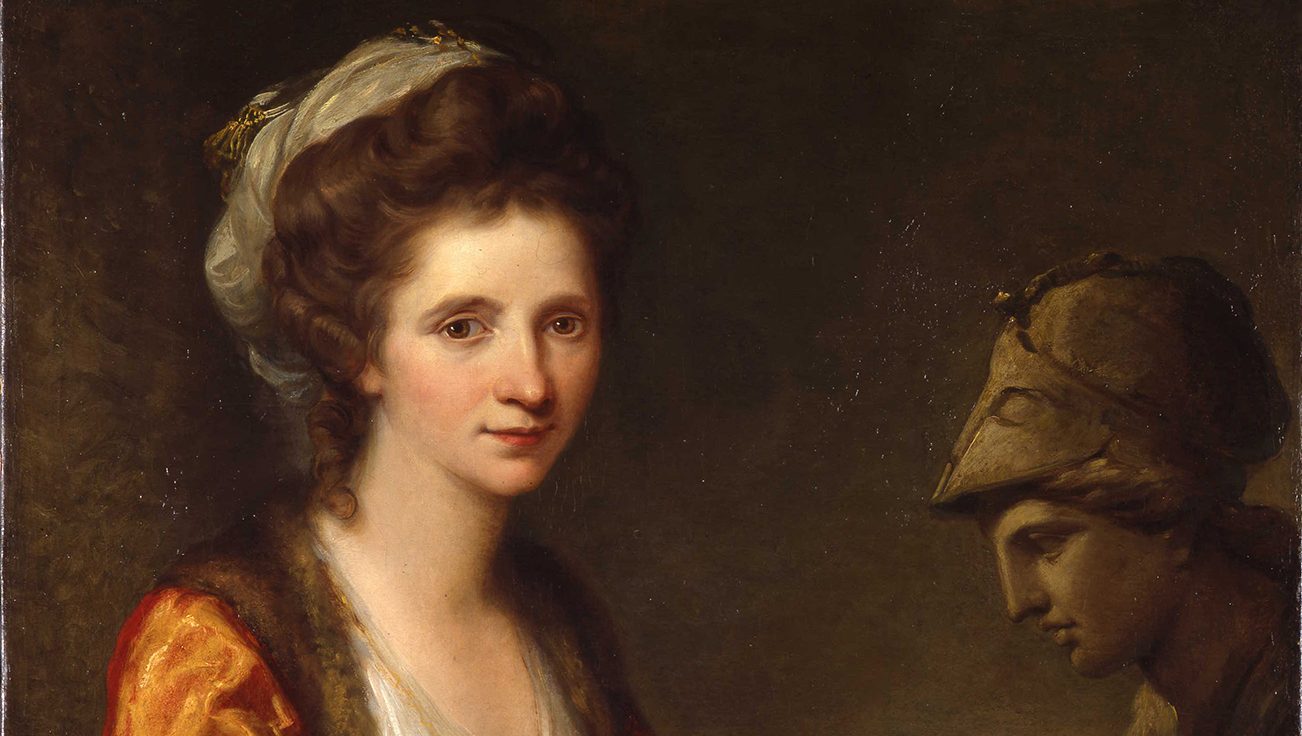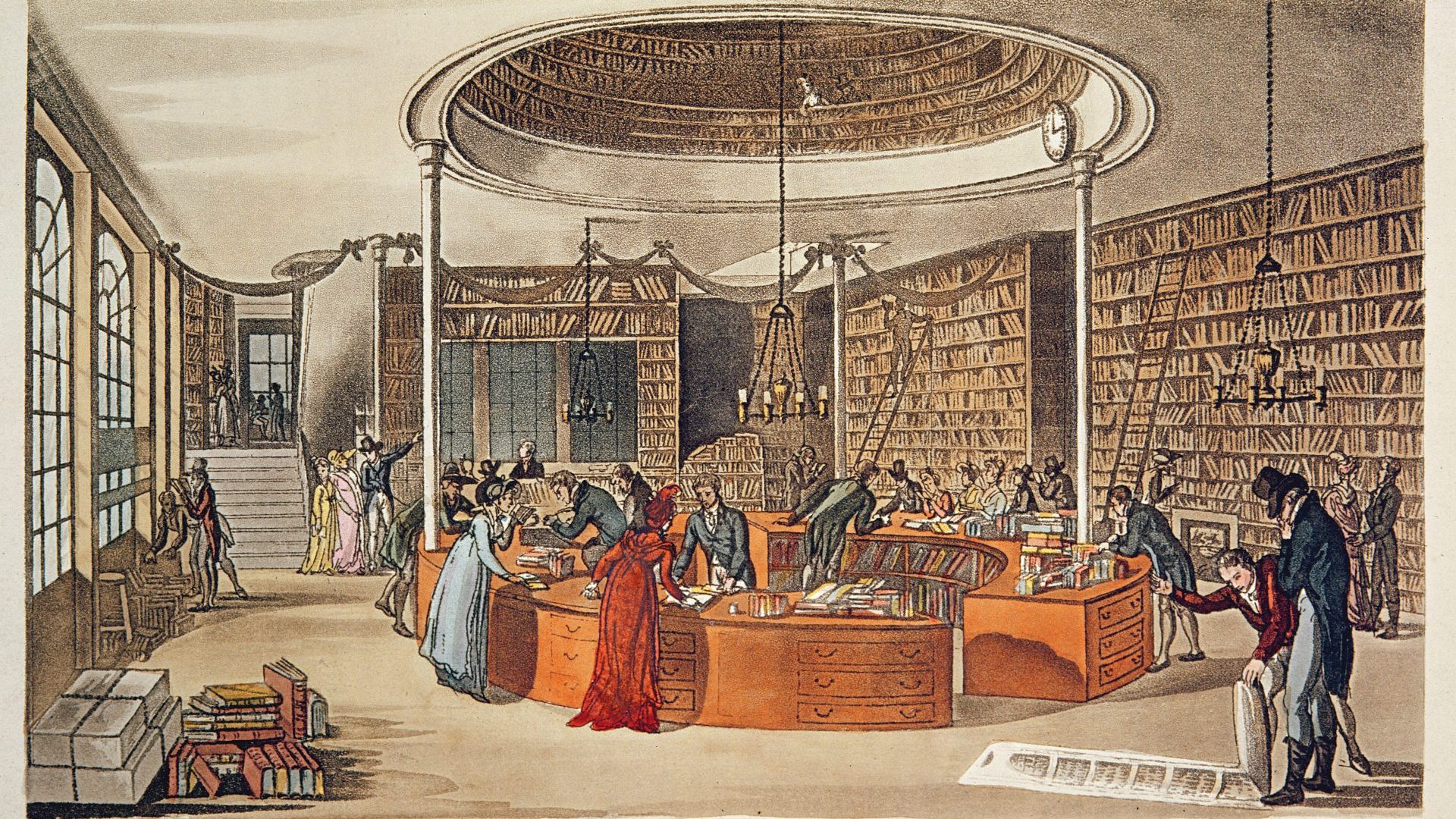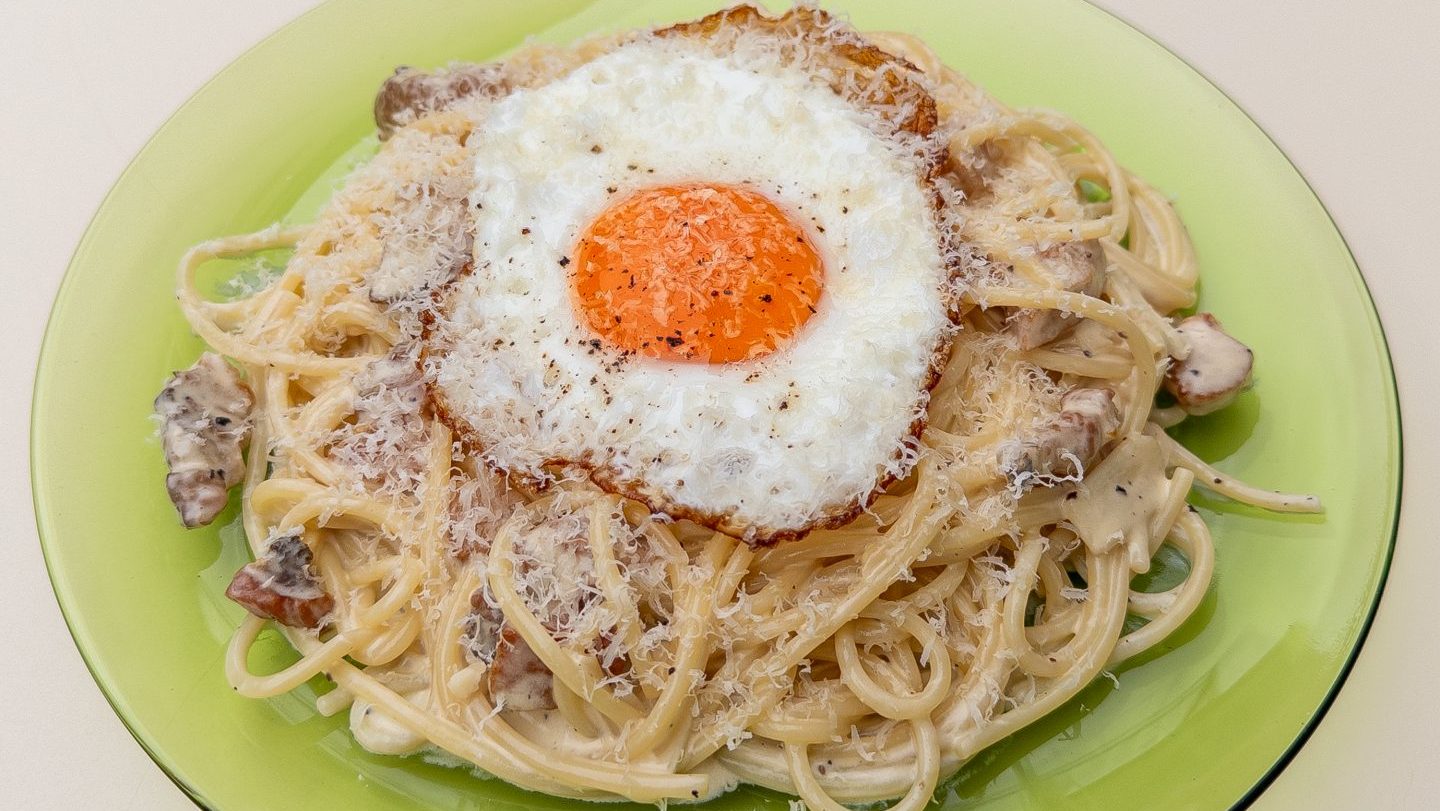In her 50th year, now an established painter renowned across Europe, the Swiss-born Angelica Kauffman created a vast self-portrait that unexpectedly questioned her very vocation. Entitled Self-Portrait at the Crossroads between the Arts of Music and Painting, it depicts Kauffman herself choosing between these two disciplines.
With her right hand, she holds the left hand of the dejected figure of Music warmly but consolingly, as if to say, “You’re marvellous, and I would have loved to, but…”. With her left, she indicates, almost apologetically, her path towards Art, gesturing to the palette and brushes that Art holds in one hand while pointing urgently with the other to the waiting world beyond this touching scene.
The suggestion is that Kauffman could have made a success of careers in either art form. A retrospective of Kauffman’s painting, at the Royal Academy of Arts in London, gauges the scale of her loss to music – she was proud of her skills at the clavichord, and in an early self-portrait now in the Tyrolean State Museum shows herself displaying sheet music.
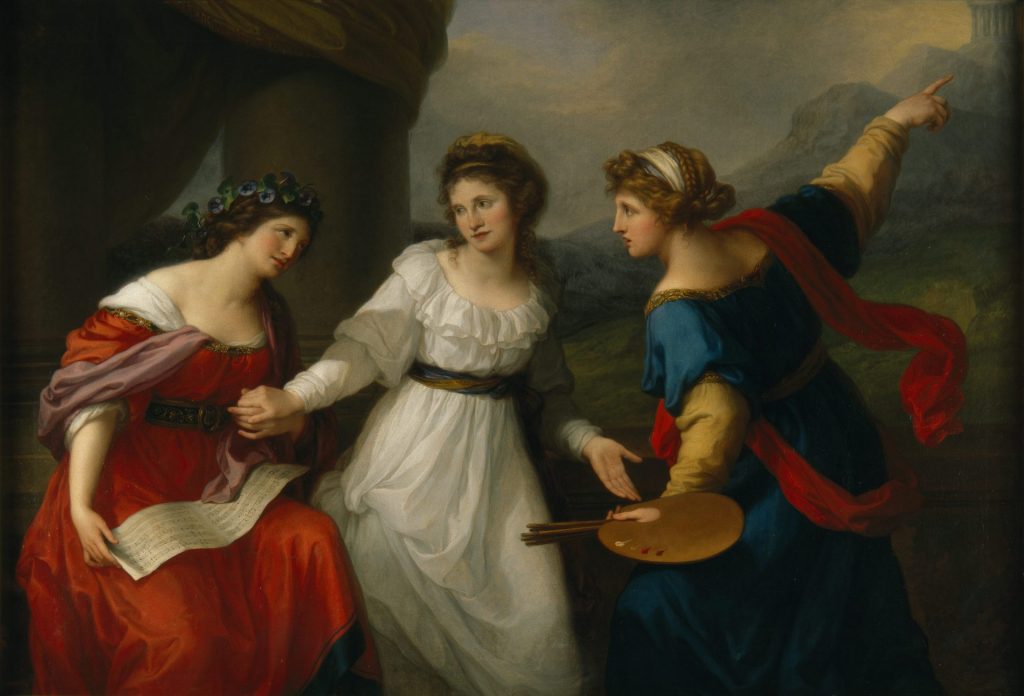
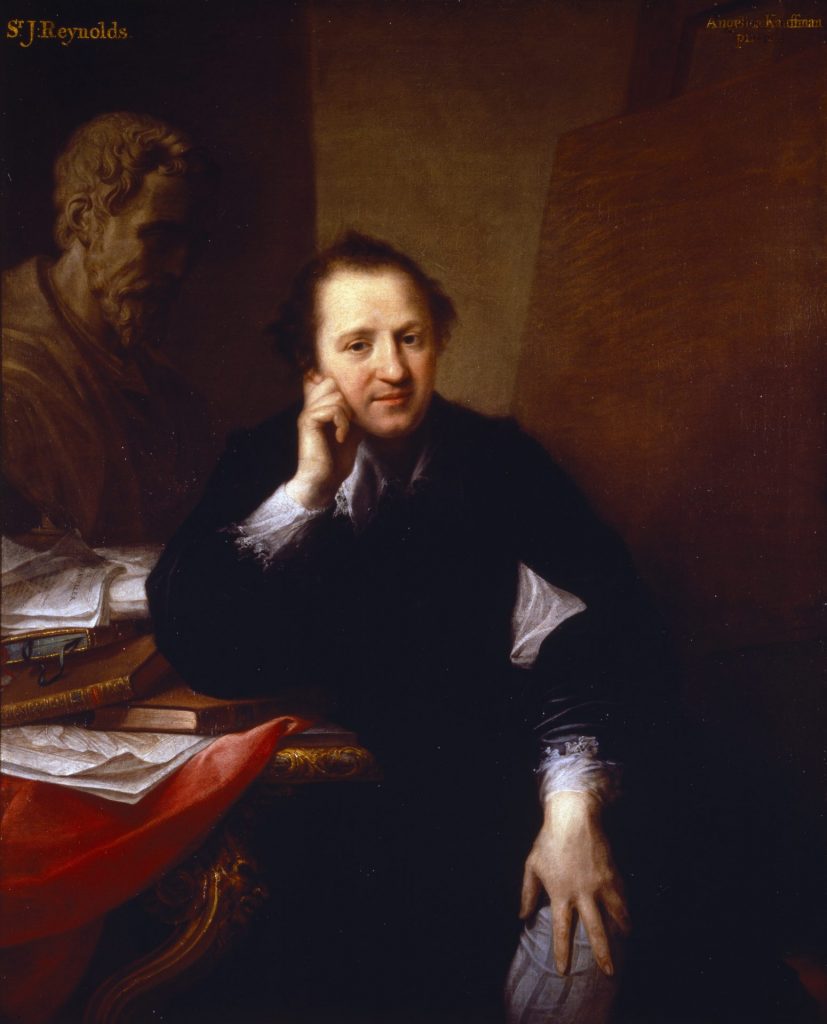
Like the Italian painter Artemisia Gentileschi half a century earlier, she often served as her own model – she need not look outside for a woman’s face and figure, as male artists must, and it saved money.
Even-featured and with a fetching outline, she cuts a dash as the personification of the four principles of art: Invention, Composition, Design and Colouring, commissioned by Royal Academy of Arts for its former home, Somerset House. Two of these, Design and Composition, are exhibited here, the other two remain in the Royal Academy collection.
Of these, perhaps the loveliest is Colouring, in which the artist loads her brush with the colours of the rainbow that arcs overhead, her falling Titian-red garment framing the subtle hues of flowers at her feet.
This perpetual reminder of Kauffman at the Royal Academy is appropriate, for she made history there as one of its two female founder members, 10 years earlier, in 1768. That there should be any female founders is something of a marvel, even if one, Mary Moser, was the daughter of one of the founding men, George Michael Moser.
That Kauffman was born outside Britain undoubtedly added to her prestige at a time when London looked to Europe, and in particular to Italy, for excellence. Kauffman had spent many years in Rome.
Born near the Lichtenstein border in Chur, in 1741, the only child of a painter, Johann Joseph Kauffman, and his wife, Cleophea, she was around 10 years old when the family went to serve a ruling family in Como in northern Italy, then under Austrian control. From here she was taken south to see and copy the great masters – and to sing.
With the death of her mother in 1757, the young woman toured to Parma, Bologna, Florence, Rome and Naples, studying Guido Reni, Annibale Carracci, Guercino, Raphael and others, and exploring antiquities.
She favoured history painting, considered the highest form of art by the academies, but it was her portrait of the great British actor and theatre producer David Garrick, who sat for her in Naples, that was her calling card at the Royal Academy. Today’s gallery-goers may not warm so much to her noble but remote historical scenes as to the capturing in depth of characterful personalities such as Garrick.
By this time, already elected to the academies of Florence and Bologna, she was now also a member of the prestigious Accademia di San Luca in Rome. So great an honour was this that upon her death in 1807 she would be accorded a grand funeral procession through the streets of Rome, organised by the sculptor Antonio Canova and others, two of her history paintings born aloft.
This impressive status, coupled with the megastardom of Garrick at this time, made the actor’s portrait stand out at Free Society of Artists in 1765, and established Kauffman’s name so firmly in London that the following year she could open a studio in Charing Cross, at the then heart of the art community, and later in smart Golden Square in Soho. Within months she was being commissioned by the Queen Mother and championed by the leading London painter of the day, Joshua Reynolds.
The two artists painted each other’s portraits. Curiously, perhaps, Reynolds is depicted not at his easel, but seated pensively, head in hand, alongside a muddle of papers and journals, among them a bound copy of Dr Johnson’s essays, The Idler. A bust of Michelangelo looks down on his disciple, and Kauffman herself seems to complete the trio in 1767, with her impressive fabric painting, Reynolds’s Van Dyck outfit calling for velvet and lace.
A disastrous marriage to a conman behind her, and as a founding member of the new Royal Academy of Arts, she was included in a team picture of 1771 by Johan Zoffany. But because he depicts the academics at a life class, the two women are relegated to portraits on the wall of the imagined room.
Two female founders out of 40 might have been a more impressive start had the academy not failed to elect a further woman until Dame Laura Knight in 1936.
Even though she was one of four top artists commissioned to decorate St Paul’s Cathedral, a project never realised, Kauffman came up against scurrilous sexism when a satirical painting showed her as the puppet of Reynolds, the first president of the RA, and also stripped her of all but her black stockings. Kauffman succeeded in her appeal to the RA to have the picture taken down; otherwise, she said, she would remove all her own paintings.
She had been the toast of London for 15 years before marrying the Venetian painter Antonio Zucchi and moving on. In 1782, with her customary good timing, she opened a studio by the Spanish Steps in Rome, attracting influential and well-heeled travellers on the Grand Tour.
She was admired by the royal families of Europe, Poland and Russia while also appealing to European intellectuals, notably Goethe. And it was then that she raised the question: should I have chosen art and music?
We will never know what she might have achieved as a singer or at the keyboard, but her undoubted art legacy is not so much as a painter but as a landmark figure in art history. The portraits of Garrick, her friend Emma Hamilton, the art historian and archaeologist Johann Joachim Winckelmann and of Reynolds stand out, as do her self-portraits, images of an attractive and unageing woman of charm and intellect.
Unlike her portrait of Reynolds, her Self-Portrait with Stylus and Portfolio (1784), loaned to London by Munich, shows a working artist, sleeves rolled up, with a gaze that signals the intensity of concentration and a pose that gives her trade an air of nobility.
The many women in active and heroic roles distinguishes her history painting more than its technique. The three industrious women in Cleopatra Adorning the Tomb of Mark Anthony busy themselves with a lamp, flowers and garland, while a sleepy-eyed soldier in the background slumps over his forearms. Meanwhile, in a rarely depicted episode, the life of a comatose Edward I of England is saved by his wife, Eleonora, who sucks the venom from his arm, pierced by a poisoned arrow.
Given the prominence of these unsung heroines, it is surprising – or perhaps not – that of the two pictures that accompanied her funeral cortege, three out of the four figures are male: Old Testament prophet Nathan with David, and Christ, depicted with the Samaritan Woman, a scene enlivened by the lavish application of a vivid, luscious, Titian red.
For bored and faithful Penelope, wife of Odysseus, there is no such illumination. All but defeated by the task of making by day and unpicking by night the needlework that keeps would-be suitors at bay, her waistline thickened by her sedentary life, she flops over her loom and gazes hopelessly into thin air.
Even the hound lying dopily on his master’s longbow looks downcast. Domestic tedium, if not on this scale, might have been the lot of many women of Kauffman’s time, but it was not hers.
By the time of her death in Rome, she had exhibited work at the Royal Academy across nearly 30 years, been invited to add her self-portrait to the collection of leading artists’ self-portraits at the Uffizi in Florence (alongside what was for a long time considered to be the self-portrait of Michelangelo), been invited by the Pope to paint an altarpiece in Loreto, near the Adriatic coast in Italy, and been allowed by occupying French troops to maintain her studio in Rome. A remarkable tally.
The painter of heroines was a heroine in her own right – not the greatest artist, but one who deftly negotiated the tastes of different countries, decade after decade.
Like patient Penelope, she is always with a day’s work behind her and another day’s work in store. But while Penelope was labouring to keep her man, Kauffman was doing it for herself.
Angelica Kauffman is at the Royal Academy of Arts, London, until June 30


